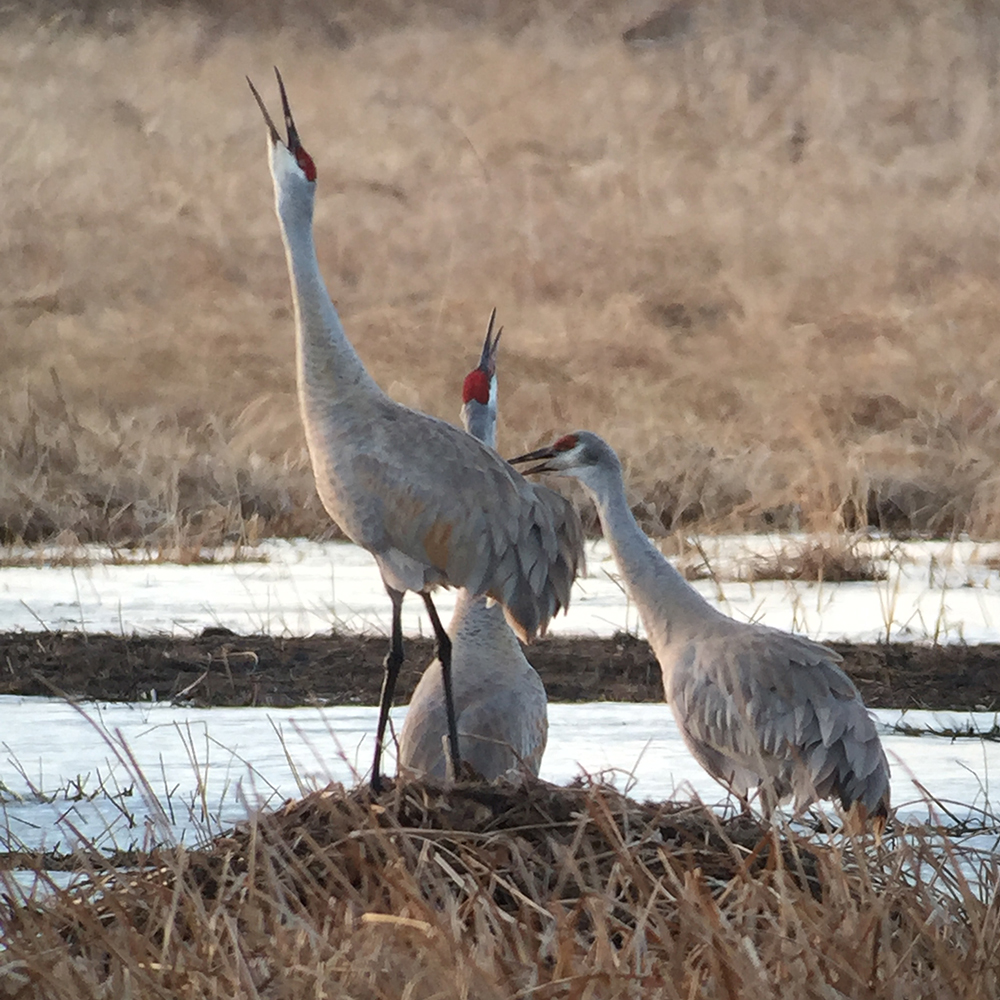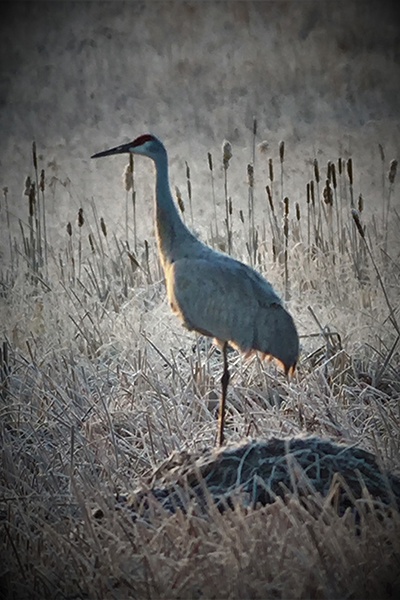As the promise of spring unfolds, our Co-founder George Archibald is returning to a small wetland in Sauk County, Wisconsin, where last year he spent countless hours documenting three young Whooping Cranes and their Sandhill Crane cousins. This year, George will share regular updates on the cranes through our social media and his Travels With George blog series. Read George’s previous field entry here.

March 6 to 8, 2021
One of the principles of crane biology is that males return to the area where they were raised, the natal area, to establish breeding territories. Perhaps their parents are more likely to tolerate their presence and allow a portion of the wetland as their breeding territory than they would be to strangers. The first cranes to return to the marsh were males. Perhaps the males were raised there. They stand on muskrat mounds and in nearby fields, repeatedly calling as if to advertise their availability for pairing. The males initially search for wetland real estate. Then they advertise for mates.
In contrast, females disperse widely from their natal areas, searching for males, and perhaps preferably males with wetland breeding habitat. During my observations the past three days, two females appeared in flight, calling continuously and landed near the males, walked among them, checking them out, and then departed.
Today a lone female appeared and stood in the soy field beside the wetland where the three males displayed. Communication was happening.
Initially, Pair 4 appeared at the north side of the wetland where the Whooping Cranes nested last year. Likely they nested there for many years before the Whooping Cranes appeared in 2019. Last year, they were driven from that area of the marsh and nested beside a small pond over a line of trees on the north side of the Whooping Crane territory. They hatched two chicks and fledged one. This March 6, while the Whooping Cranes are still on their wintering area in western Kentucky, the P4 Sandhills were on the Whooping Crane territory and have remained on the Whooping Crane territory through much of my 6 to 9 a.m. observation period. There is harmony between the pair and their offspring, and the young crane sometimes Unison Calls with her parents. During the Unison Call, the postures of the male and female crane are different. That’s how I know the young crane is a female.

March 6, Pair 1 appeared on their territory in the southwest of the wetland. They Unison Called back and forth with P4 many times, and the male of P1 threatened the nearby solo males. They were accompanied by a third crane, presumably a juvenile from 2020. Unlike the relationship of P4 with their female colt from last year, there was tension between P1 and their offspring. This tension resulted in P1 attacking and driving away their offspring on March 8.
March 8, Pair 3 appeared in the southwest of the wetland. They also were in the process of driving off their juvenile from the previous year. Both the offspring of Pair 1 and P3 were large birds suggesting their sex as male. In contrast, the female juvenile of P4 was much smaller than her father. Based on this tiny sample size, I wonder if female juveniles are tolerated more than juvenile males upon return to the breeding areas when the young crane is approaching one year of age?
So this is the state of the cranes at the marsh today – three breeding pairs on their territories, three solo males advertising for females and unmated females coming and going.
Two pairs are driving away their juveniles. One pair is in harmony with their juvenile. Now we wait for the return of Pair 2 (on whose turf the solo males now stand), Pair 5 (that nested unknown to the Whooping Cranes in a wooded area of the Whooping Crane’s territory), and the Whooping Cranes (expected to drive Pair 4 from their territory).
Oh yes, on March 7, at 7:35 a.m., two coyotes trotted across the soy field that borders the south side of the wetland. On March 8, at 7:15 a.m. on coyote did likewise.
The wildlife drama continues.
 Story submitted by George Archibald, Co-founder and Senior Conservationist. Click here to learn more about our work in North America.
Story submitted by George Archibald, Co-founder and Senior Conservationist. Click here to learn more about our work in North America.
